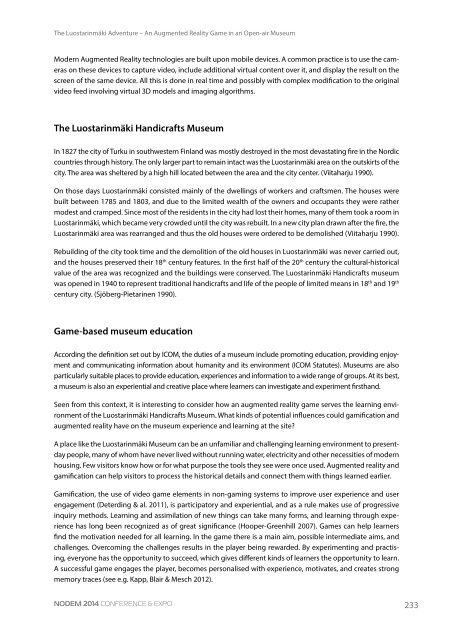NODEM 2014 Proceedings
NODEM 2014 Proceedings
NODEM 2014 Proceedings
You also want an ePaper? Increase the reach of your titles
YUMPU automatically turns print PDFs into web optimized ePapers that Google loves.
The Luostarinmäki Adventure – An Augmented Reality Game in an Open-air Museum<br />
Modern Augmented Reality technologies are built upon mobile devices. A common practice is to use the cameras<br />
on these devices to capture video, include additional virtual content over it, and display the result on the<br />
screen of the same device. All this is done in real time and possibly with complex modification to the original<br />
video feed involving virtual 3D models and imaging algorithms.<br />
The Luostarinmäki Handicrafts Museum<br />
In 1827 the city of Turku in southwestern Finland was mostly destroyed in the most devastating fire in the Nordic<br />
countries through history. The only larger part to remain intact was the Luostarinmäki area on the outskirts of the<br />
city. The area was sheltered by a high hill located between the area and the city center. (Viitaharju 1990).<br />
On those days Luostarinmäki consisted mainly of the dwellings of workers and craftsmen. The houses were<br />
built between 1785 and 1803, and due to the limited wealth of the owners and occupants they were rather<br />
modest and cramped. Since most of the residents in the city had lost their homes, many of them took a room in<br />
Luostarinmäki, which became very crowded until the city was rebuilt. In a new city plan drawn after the fire, the<br />
Luostarinmäki area was rearranged and thus the old houses were ordered to be demolished (Viitaharju 1990).<br />
Rebuilding of the city took time and the demolition of the old houses in Luostarinmäki was never carried out,<br />
and the houses preserved their 18 th century features. In the first half of the 20 th century the cultural-historical<br />
value of the area was recognized and the buildings were conserved. The Luostarinmäki Handicrafts museum<br />
was opened in 1940 to represent traditional handicrafts and life of the people of limited means in 18 th and 19 th<br />
century city. (Sjöberg-Pietarinen 1990).<br />
Game-based museum education<br />
According the definition set out by ICOM, the duties of a museum include promoting education, providing enjoyment<br />
and communicating information about humanity and its environment (ICOM Statutes). Museums are also<br />
particularly suitable places to provide education, experiences and information to a wide range of groups. At its best,<br />
a museum is also an experiential and creative place where learners can investigate and experiment firsthand.<br />
Seen from this context, it is interesting to consider how an augmented reality game serves the learning environment<br />
of the Luostarinmäki Handicrafts Museum. What kinds of potential influences could gamification and<br />
augmented reality have on the museum experience and learning at the site?<br />
A place like the Luostarinmäki Museum can be an unfamiliar and challenging learning environment to presentday<br />
people, many of whom have never lived without running water, electricity and other necessities of modern<br />
housing. Few visitors know how or for what purpose the tools they see were once used. Augmented reality and<br />
gamification can help visitors to process the historical details and connect them with things learned earlier.<br />
Gamification, the use of video game elements in non-gaming systems to improve user experience and user<br />
engagement (Deterding & al. 2011), is participatory and experiential, and as a rule makes use of progressive<br />
inquiry methods. Learning and assimilation of new things can take many forms, and learning through experience<br />
has long been recognized as of great significance (Hooper-Greenhill 2007). Games can help learners<br />
find the motivation needed for all learning. In the game there is a main aim, possible intermediate aims, and<br />
challenges. Overcoming the challenges results in the player being rewarded. By experimenting and practising,<br />
everyone has the opportunity to succeed, which gives different kinds of learners the opportunity to learn.<br />
A successful game engages the player, becomes personalised with experience, motivates, and creates strong<br />
memory traces (see e.g. Kapp, Blair & Mesch 2012).<br />
<strong>NODEM</strong> <strong>2014</strong> Conference & Expo<br />
233


